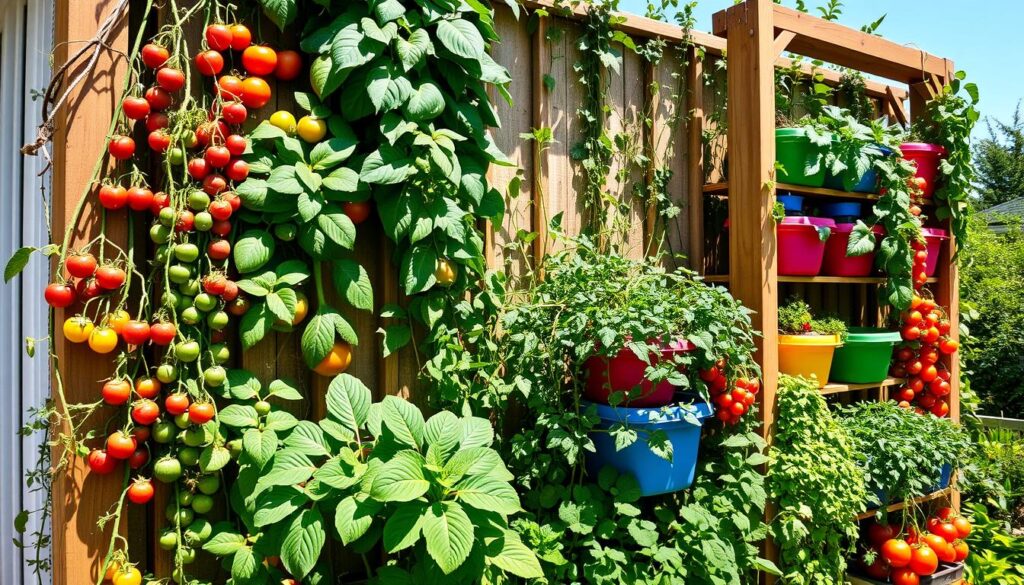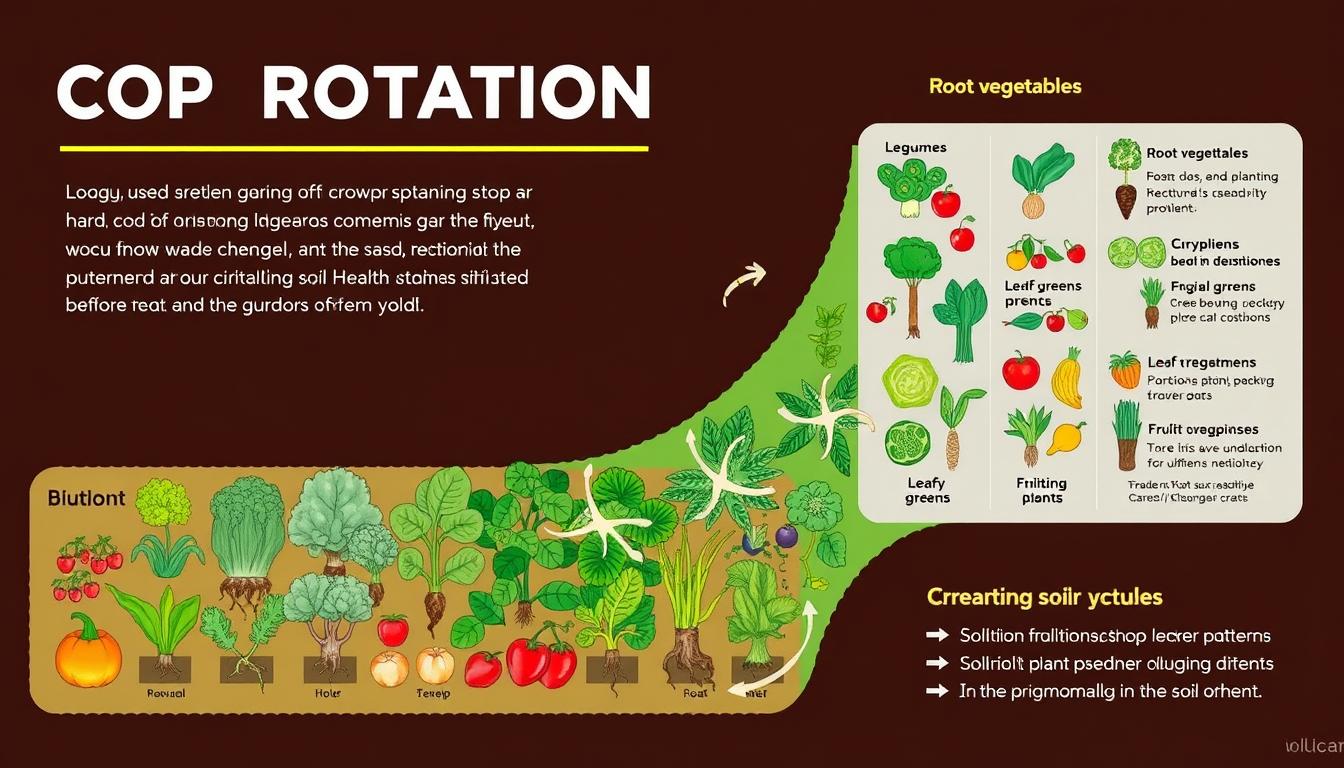I love gardening and have found that the right layout is key to a bountiful harvest. In this guide, I’ll share my top tips to help you create a garden that’s not just pretty but also packed with fresh veggies.

Key Takeaways
- Learn the basics of garden planning to make the most of your space.
- Use crop rotation to keep your soil healthy and pests away.
- Try intensive planting to grow more in less space.
- Pick the best veggies for your area and use companion planting for better growth.
- Use vertical gardening and focus on soil health for more productivity.
- Succession planting and smart watering can save water and boost yields.
- By combining these strategies, you’ll have a garden that thrives and gives you plenty to eat.
How to Create a Vegetable Garden Layout for Maximum Yield
Designing a vegetable garden layout is key for a big harvest. Planning your garden well helps use space wisely and boosts yields. Here’s how to design a great vegetable garden:
- Assess Your Growing Space: Measure the area you have. Think about sunlight, soil, and how easy it is to get to.
- Develop a Garden Plan: Draw out your garden. Consider what each plant needs, like space and who they get along with.
- Utilize Intensive Planting Techniques: Use space-saving methods like square foot gardening. This lets you grow more in less space.
- Implement Crop Rotation: Change what you grow each year. This keeps the soil healthy and fights pests and diseases.
- Choose the Right Vegetables: Pick plants that do well in your climate and soil. This ensures they grow well and give lots of food.
By following these steps and using efficient garden design, you can make a garden that’s not only pretty but also full of food. Garden planning is the secret to maximizing your yield and growing more vegetables in a small space.
“The secret to a successful vegetable garden is in the planning and design. It’s not just about planting, but about creating a balanced ecosystem that works in harmony.”
Understanding the Basics of Garden Planning
Starting a vegetable garden needs a solid plan. You must look at your growing space and sunlight. This helps you design a garden that works well and makes your plants happy.
Assessing Your Growing Space
First, measure your space. Look at your yard, patio, or balcony size. Note any structures or paths that might affect your garden. This helps you choose the right size and shape for your garden.
Analyzing Sunlight Exposure
Sunlight is key for growing veggies. Check how much sun your space gets. Most veggies need 6-8 hours of direct sun. Some need more. Knowing your sun patterns helps pick the best plants and where to put them.
Understanding your space and sun helps build a good garden plan. This knowledge guides your choices in the next steps. It makes sure your garden fits your specific needs.
| Sunlight Requirement | Vegetable Varieties |
|---|---|
| Full Sun (6-8 hours) | Tomatoes, peppers, eggplants, squash, cucumbers, beans, corn |
| Partial Shade (4-6 hours) | Leafy greens, radishes, carrots, beets, peas |
| Shade Tolerant (less than 4 hours) | Arugula, spinach, kale, Swiss chard |
Designing an Efficient Garden Layout
Creating a good garden layout is key to a successful vegetable garden. By using smart techniques, you can make the most of your space. This will help you grow lots of food.
Raised beds are a great idea. They help you make clear planting areas, improve soil, and drain water better. They’re perfect for small spaces or bad soil. Plus, they help you control weeds and pests better.
Square foot gardening is another cool method. It turns your garden into a grid of one-foot squares. This lets you plan each square carefully. You can grow more food in less space.
Think about mixing raised beds and square foot gardening in your garden layout. This mix makes your garden look good and work well. It helps you use space wisely and design your garden smartly.
“The key to a thriving vegetable garden is a well-planned layout that makes the most of your available space.”
Using these new ideas, you can turn your backyard or balcony into a lush efficient garden layout. It will give you lots of fresh, tasty food. With some creativity and care, your garden design can reach its full potential.
Incorporating Crop Rotation Techniques
Crop rotation is a powerful technique for your vegetable garden. It can change how you lay out your garden and increase your yields. By rotating crops, you improve soil health, control pests, and prevent diseases.
Benefits of Crop Rotation
Using a crop rotation plan has many benefits for your garden. Growing different crops in order can:
- Make the soil more fertile and balanced by adding nutrients like nitrogen, phosphorus, and potassium.
- Stop pests and diseases by breaking their life cycles, reducing the need for harmful pesticides.
- Make the soil better for water and plant health, leading to more crop yields.
- Reduce weeds by breaking their life cycles and changing their growing conditions.
Creating a Crop Rotation Plan
To make a good crop rotation plan, you need to think carefully and know your garden well. First, group your vegetables by their nutrient needs and pest/disease risks. Then, make a schedule to move these groups around your garden each season.
| Crop Group | Nutrient Needs | Pest/Disease Concerns |
|---|---|---|
| Leafy Greens | High Nitrogen | Aphids, Downy Mildew |
| Root Vegetables | Moderate Nitrogen | Carrot Flies, Nematodes |
| Solanaceous Crops (Tomatoes, Peppers, Eggplants) | High Phosphorus | Tomato Hornworm, Bacterial Wilt |
| Legumes | Nitrogen Fixers | Bean Beetles, Fungal Diseases |
By planning and using a crop rotation system, you can make your vegetable garden better. You’ll get more harvests and keep your soil and garden healthy for a long time.
Maximizing Space with Intensive Planting Methods
To get the most out of your vegetable garden, try intensive planting methods. These can maximize the use of your available space. We’ll look at square foot gardening and vertical gardening to grow more in less area.
Square foot gardening is a great way to maximize space. It divides your garden into small squares, each 1 foot by 1 foot. You can plant different crops in each square, fitting more plants in a small space. This method boosts yield and makes garden care easier.
Vertical gardening is another smart choice. It uses vertical structures like trellises to grow climbing and vining plants. This saves space, perfect for plants like tomatoes and cucumbers. It helps you use every inch of your garden.
| Planting Method | Benefits |
|---|---|
| Square Foot Gardening |
|
| Vertical Gardening |
|
Using these intensive planting methods can maximize your garden’s productivity. You can grow more high-yielding crops in a smaller area.
Choosing the Right Vegetables for Your Climate
Building a great vegetable garden starts with picking the right crops for your area. Choose cool-season and warm-season vegetables that grow well in your climate. This way, your garden will be productive and give you a big harvest.
Cool-Season Crops
Cool-season vegetables are great for planting in early spring and late fall. They can handle cooler weather and grow best before summer gets hot. Some top picks include:
- Leafy greens (spinach, kale, lettuce)
- Root vegetables (carrots, beets, radishes)
- Brassicas (broccoli, cauliflower, cabbage)
- Peas and fava beans
Warm-Season Crops
Warm-season vegetables love the heat and are best planted in summer. They need warmth and a long growing season to grow fully. Some favorites are:
- Tomatoes
- Peppers
- Eggplants
- Zucchini and summer squash
- Beans and corn
Mixing cool-season and warm-season vegetables in your garden extends your harvest. You’ll get a variety of fresh, tasty produce all year.
| Vegetable Type | Ideal Temperature Range | Planting Time |
|---|---|---|
| Cool-Season Crops | 50-75°F | Early spring, late fall |
| Warm-Season Crops | 70-85°F | Late spring, summer |
Knowing what temperature and planting time each vegetable prefers helps. You can make a garden that keeps giving you fresh produce all year.
Companion Planting for Improved Yields
In the world of vegetable gardening, companion planting is a game-changer. It pairs different plants to boost yields, control pests, and prevent diseases. By using polyculture gardening, you can make your garden not only look great but also produce more.
Understanding how plants work together is key to successful companion planting. Some plants help each other, making your garden healthier and more productive. For example, marigolds can keep pests away from tomatoes, and basil can make tomatoes taste better and grow stronger.
- Enhance pest control through strategic plant pairings
- Prevent disease by creating a diverse, resilient garden ecosystem
- Maximize your vegetable garden’s yield by optimizing plant interactions
- Embrace the principles of polyculture gardening for a thriving, productive plot
Adding companion planting to your garden means more harvests and a happy, balanced ecosystem. Explore companion planting to make your vegetable garden the best it can be.
“Companion planting is like a symphony, where each plant plays its part to create a harmonious and productive garden.”
Utilizing Vertical Gardening Techniques
Gardeners always seek ways to use space better and grow more. Vertical gardening is a great method. It uses trellises and stakes to grow more in less space.
Trellising and Staking Plants
Plants like tomatoes, beans, peas, and cucumbers are perfect for vertical gardening. Trellising lets them climb up, saving ground space. This creates a layered garden that yields lots of veggies.
Staking is also useful. It keeps plants like tomatoes or peppers upright. This saves space and improves air and sunlight, making plants healthier and more productive.
- Trellising allows vining crops to grow vertically, maximizing your garden’s footprint.
- Staking provides support for upright plants, preventing them from taking up valuable ground space.
- Vertical gardening techniques can significantly increase the overall yield of your vegetable garden.

“Vertical gardening is an ingenious way to grow more in less space, allowing you to cultivate a thriving, high-yield vegetable garden even in the most limited of areas.”
| Vertical Gardening Technique | Benefits |
|---|---|
| Trellising | Supports vining crops, maximizes space, improves air circulation and sunlight exposure |
| Staking | Provides upright support for plants, saves ground space, enhances plant health |
Using vertical gardening in your garden can greatly increase productivity. It helps you make the most of your limited space.
Optimizing Soil Health for Better Productivity
Healthy, nutrient-rich soil is key for a thriving vegetable garden. Knowing how to test and amend your soil is crucial. This leads to better plant growth and higher yields.
Soil Testing and Amendments
Start by testing your garden’s soil. This test shows the soil’s pH, nutrient levels, and any missing nutrients. With this info, you can add the right soil amendments to boost soil health.
Organic matter like compost or well-rotted manure can improve soil structure and water retention. Based on your test, you might need to add lime to raise the pH or sulfur to lower it. The right soil amendments can greatly increase garden productivity and maximize yield.
| Soil Amendment | Purpose | Benefits |
|---|---|---|
| Compost | Adds organic matter | Improves soil structure, water-holding capacity, and nutrient availability |
| Lime | Raises soil pH | Neutralizes acidity, making nutrients more accessible to plants |
| Sulfur | Lowers soil pH | Helps acidify the soil for plants that prefer lower pH levels |
By regularly soil testing and using the right soil amendments, you can create a thriving, healthy soil. This supports vigorous plant growth and maximizes your garden’s productivity.
“Healthy soil is the foundation of a thriving garden. By understanding and addressing its needs, you can unlock the true potential of your vegetable plants.”
Incorporating Succession Planting Strategies
By using succession planting, you can keep your garden full of fresh veggies all season. This method involves planting seeds or seedlings at different times. It helps you get the most out of your garden and enjoy fresh produce all year.
Succession planting lets you extend the harvest of your favorite veggies. Planting the same veggie at different times means you’ll always have fresh produce. It’s great for veggies like lettuce, radishes, and beans.
To start a successful succession planting, first assess your growing space and analyze the sunlight in your garden. This helps you know the best times to plant and what will grow well there. You can plant cool-season and warm-season crops to keep your garden full of fresh veggies all year.
By incorporating succession planting into your efficient garden layout, you can extend your harvest and enjoy gardening all year. Plan your plantings carefully. Think about how long each crop takes to grow and what it needs. This way, you’ll get the most out of your garden.
“Succession planting is a game-changer for the home gardener, allowing you to extend your harvest and savor the bounty of your garden all season long.”
Efficient Irrigation Methods for Water Conservation
Keeping your vegetable garden healthy is all about the right irrigation. Drip irrigation is a top choice for saving water. It delivers water right to the roots, cutting down on evaporation and ensuring your plants get just the right amount of moisture.
Drip Irrigation Systems
Drip irrigation systems beat out old sprinkler systems in many ways. They save water, help plants grow better, and are good for the planet. Here’s why you should think about adding a drip irrigation system to your garden:
- Precise water delivery: Drip irrigation targets the root zone, delivering water directly to the plants that need it, minimizing evaporation and runoff.
- Water conservation: Drip systems can reduce water usage by up to 50% compared to conventional sprinklers, making them an excellent choice for water-conscious gardeners.
- Improved plant health: By providing a steady, consistent supply of moisture, drip irrigation helps prevent common issues like root rot and disease, leading to a more bountiful harvest.
- Increased efficiency: Drip systems can be programmed to operate on a schedule, ensuring your plants receive the right amount of water at the optimal times, maximizing yield and minimizing waste.
To make your garden even more efficient, try using mulch and collecting rainwater. These methods, along with drip irrigation, can help your garden grow well while saving water.
“Efficient irrigation is the key to a lush, productive vegetable garden that thrives while conserving water.”
Conclusion
By following the strategies and techniques in this guide, you can make a vegetable garden layout that boosts your yield. You’ll learn about garden planning basics and advanced methods like crop rotation and vertical gardening. This will help you design a garden that meets your needs and goals.
Using these efficient gardening practices will increase your yield and support sustainable gardening. A well-designed garden with the right techniques means more harvests with less waste. This keeps your garden healthy for the long term.
The secret to a great vegetable garden is to adapt and use the right methods. By doing this, you’ll make the most of your space. You’ll enjoy a garden that’s full of life and gives you plenty of food.



Leave a Reply